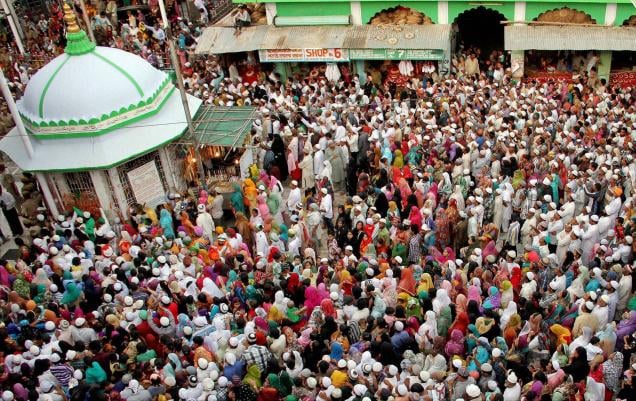
Gathering at a religious festival in Ajmer, India. This northern city of 550,000 has been selected to become a smart city, with modern infrastructure systems operated by “smart” technology. PM Narendra Modi unveiled the $7.5b plan on June 25. But will it work? The jury is still out. Photo: The Hindu (newspaper)
On June 25, 2015, Indian Prime Minister Narendra Modi unveiled a plan to modernize the infrastructure of 100 cities. The Indian government is devoting $7.5 billion to the initiative, with a goal of completing the upgrades by 2022. Yet there is criticism that the idea is destined to fail as it is putting the cart before the horse: attempting to bring Indian cities into the 21st century when many are barely in the 20th.
Modi’s vision is based on the cutting-edge design of so-called smart cities, which use technology based on computer networks to create “grids in which water, electricity, waste removal, traffic, hospitals and schools are seamlessly integrated with information technology to run them more efficiently.” Prototypes have been installed in South Korea, India and Abu Dhabi.
Adapting the smart city to India faces significant challenges. Notable among them is that Indian political, economic and cultural focus has traditionally been on its villages. Despite its burgeoning population, creating policies centered on villages has been practiced for decades. Only recently has attention shifted to cities, which politicians can no longer ignore. Now about 350 million Indians live in cities; staggeringly, this figure is projected to nearly double (to 600 million) by 2030. Yet the infrastructure of many of India’s cities cannot support their strain currently, let alone the additional burden of population growth expected soon.
For example, take Ajmer in northern India, with a population around 550,000. It is one of the cities selected for upgrade by Modi. In May 2015 representatives from IBM, Oracle and several other companies visited Ajmer to plan out (and promote) how smart city technology will fix the city’s debilitating water and waste management and traffic problems.
Yet, Ajmer only provides running water for two hour per day. A pitifully small number of homes are connected to a sewage system. Dirty water freely flows through open drains. And only 2 traffic lights function properly in the entire municipality. As Mukesh Aghi — president of the U.S.-India Business Council, which organized the meeting with U.S. companies in May — deftly observes, “While we are trying to bring 21st-century technology, we also need to sort out some 19th-century challenges in Ajmer.” Suresh Mathur, a retired schoolteacher in Ajmer, asks, “Can we first work toward becoming a functioning city before aspiring to be a smart city? We lack even the basic services that a city should typically provide.”
Technology has the potential to solve many problems but also tends to create just as many. The infrastructure problems in India are severe and also unique, meaning solutions that worked elsewhere would likely not work there. Of course the smart city model could succeed if adapted properly, but this process needs to be carefully planned and tested. Thus expecting fully functioning modern cities by 2022 seems completely unreasonable.
I saw a BBC program recently that talked about the many problems with installing highway overpasses and alternate routes aimed to combat traffic congestion in Mumbai. Dozens of these structures sit half-completed, with no progress being made and no realistic completion date in sight. With this in mind jumping directly from antiquated to modern doesn’t seem feasible.
Maybe Modi should focus on making the infrastructure of India’s cities average, before arriving at smart.